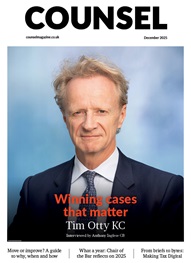*/
The percentage of women at the Bar has remained unchanged over the last five years, figures released by the Bar Standards Board revealed.
While almost half of those called to the Bar are women, they are leaving in disproportionate numbers compared to men and still make up only around 36% of the practising Bar (an increase of 0.9% since 2014) and a figure that has not changed significantly since 2010.
There remains a slow rate of progression and women account for only 13% of QCs.
Commenting on the Bar Council’s Momentum Measures report, the Bar Standards Board said that gender balance among practising barristers ‘is unlikely to be achieved if current trends persist’.
The figures for ethnic minority barristers have remained almost static, at 12%, up only 1% on the previous year. While only 1.5% class themselves as having a disability, up 0.5% from a year ago.
Barristers appeared reluctant to declare details of their sexual orientation, religion or socio-economic background. The BSB’s data showed that more that 70% of the Bar did not disclose any of these details. Fewer than 1% said they were male homosexuals and only 0.2% said they were lesbians.
The figures were published as the BSB launched a survey to gather information on women’s experiences of the equality rules of the BSB Handbook, which were introduced in 2012. The results will be used to review the rules to see whether further regulation is needed to improve the retention and progression of women.
BSB director-general, Dr Vanessa Davies, said: ‘I don’t think any of us should be prepared to tolerate a situation where half of those called to the Bar are female but women then leave the profession to an extent that they become outnumbered two to one later on.’
The percentage of women at the Bar has remained unchanged over the last five years, figures released by the Bar Standards Board revealed.
While almost half of those called to the Bar are women, they are leaving in disproportionate numbers compared to men and still make up only around 36% of the practising Bar (an increase of 0.9% since 2014) and a figure that has not changed significantly since 2010.
There remains a slow rate of progression and women account for only 13% of QCs.
Commenting on the Bar Council’s Momentum Measures report, the Bar Standards Board said that gender balance among practising barristers ‘is unlikely to be achieved if current trends persist’.
The figures for ethnic minority barristers have remained almost static, at 12%, up only 1% on the previous year. While only 1.5% class themselves as having a disability, up 0.5% from a year ago.
Barristers appeared reluctant to declare details of their sexual orientation, religion or socio-economic background. The BSB’s data showed that more that 70% of the Bar did not disclose any of these details. Fewer than 1% said they were male homosexuals and only 0.2% said they were lesbians.
The figures were published as the BSB launched a survey to gather information on women’s experiences of the equality rules of the BSB Handbook, which were introduced in 2012. The results will be used to review the rules to see whether further regulation is needed to improve the retention and progression of women.
BSB director-general, Dr Vanessa Davies, said: ‘I don’t think any of us should be prepared to tolerate a situation where half of those called to the Bar are female but women then leave the profession to an extent that they become outnumbered two to one later on.’


Chair of the Bar reflects on 2025
Q&A with criminal barrister Nick Murphy, who moved to New Park Court Chambers on the North Eastern Circuit in search of a better work-life balance
Revolt Cycling in Holborn, London’s first sustainable fitness studio, invites barristers to join the revolution – turning pedal power into clean energy
Rachel Davenport, Co-founder and Director at AlphaBiolabs, reflects on how the company’s Giving Back ethos continues to make a difference to communities across the UK
By Marie Law, Director of Toxicology at AlphaBiolabs
AlphaBiolabs has made a £500 donation to Sean’s Place, a men’s mental health charity based in Sefton, as part of its ongoing Giving Back initiative
Professor Dominic Regan and Seán Jones KC present their best buys for this holiday season
Little has changed since Burns v Burns . Cohabiting couples deserve better than to be left on the blasted heath with the existing witch’s brew for another four decades, argues Christopher Stirling
Six months of court observation at the Old Bailey: APPEAL’s Dr Nisha Waller and Tehreem Sultan report their findings on prosecution practices under joint enterprise
Despite its prevalence, autism spectrum disorder remains poorly understood in the criminal justice system. Does Alex Henry’s joint enterprise conviction expose the need to audit prisons? asks Dr Felicity Gerry KC
With automation now deeply embedded in the Department for Work Pensions, Alexander McColl and Alexa Thompson review what we know, what we don’t and avenues for legal challenge